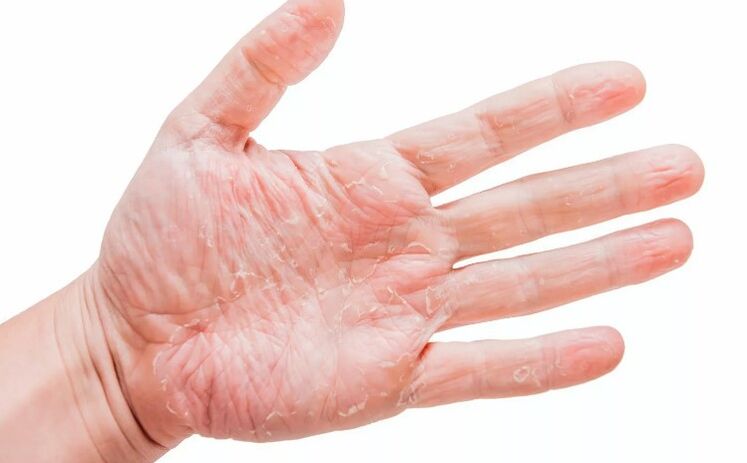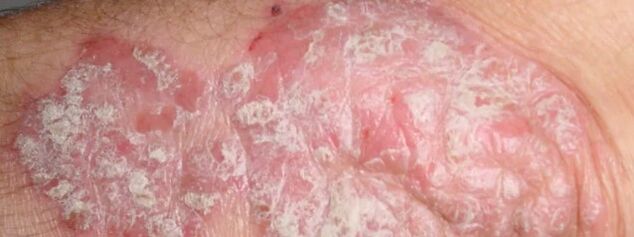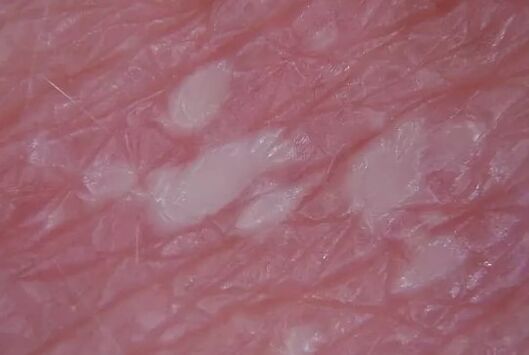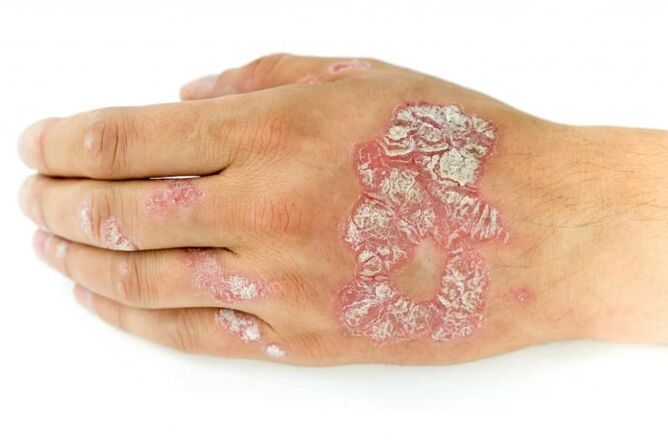Psoriasis is a chronic dermatological disease, whose pathogenesis base is an abnormally rapid growth of skin cells, which leads to appearance on the surface of the skin of compacted areas of various colors.
Today, psoriasis has become more common non -infectious dermatological disease.Psoriasis does not have a gender predisposition - men and women suffer from them equally frequently.You can get this pathology at any age, but more often the first signs of the disease appear up to 20 years.

Psoriasis is quite bad in therapy, in part due to the fact that so far the etiology and pathogenesis of this pathology are not yet clear.Moreover, there are no specific means of prevention of psoriasis, as it is impossible to determine if a person has a predisposition to the disease.
The reasons for development
At the moment, scientists cannot answer the question "why is psoriasis developing?"Two main factors of disease development are distinguished - this is a genetic and hyper -reactivity predisposition of the immunity system.
It was established until the momentThe predisposition for the development of psoriasis is inherited.But the difficulty is that it is extremely difficult to track how exactly this predisposition is inherited and after the influence of which factors psoriasis can develop.
It is believed that the following factors can induce the development of psoriasis:
- Frequent skin hypothermia as well as the effect of dry climate in it;
- Infectious processes;
- Frequent tensions;
- The use of some groups of pharmaceutical products: non -steroid anti -inflammatory drugs (especially aspirin), some hypotonic and psychotropic drugs;
Pathogenesis
At the moment, the pathogenesis of psoriasis was not finally clarified.Two main links of pathogenesis can be distinguished:
- Violation of skin keratinization.
- Interruption of the immunity system.
Together, the above factors lead to the fact that the lower layers of the epidermis for an unknown reason begin to share very quickly.This process leads to a reactive increase in the withered rate of the upper layer of epidermal cells, which is externally manifested by peeling of the skin.
Symptoms
The disease always begins sharply, without precursors of the development of the pathological process.As a rule, the first elements of the rash are located where the skin was damaged.
At the beginning of psoriasis symptoms, pink or red color papules appear on the skin.This process is accompanied by itching.The size of the elements ranges from a few millimeters to 1.5 centimeters (in some cases the elements reach large sizes).Then the elements of the rash are covered with easily separated silver scales.
Sometimes psoriasis damages nail plates.This pathology resembles fungal damage to the nails and manifests itself by the following symptoms:
- There are many small recesses on the surface of the nail;
- The edge of the nail plate thickens and acquires an opaque and yellowish color;

Another characteristic manifestation of psoriasis is psoriatic arthritis (symmetrical damage to joints and periarticular tissues).Most of the time, the pathological process develops in the interfailed joints of the feet and hands.At first, the disease manifests itself by pain and swelling and then the deformation of the affected joint develops, which may even lead to the patient's inability.It should be noted that, in rare cases, damage is also possible.Sometimes psoriatic arthritis develops even in the joints of the spine spine.
Types
The following types of psoriasis are distinguished, depending on the severity and characteristics of clinical manifestations:
- Plaquaper.This type is the most common - is diagnosed in almost 90% of people suffering from psoriasis.The elements of the rash theoretically can occur in any area of the skin.However, the most typical locations are the lumbar region, the scalp and the upper and lower ends extensors (the elbow and knee area).It should be noted that, with this psoriasis form, the pathological elements do not appear on the face, palms and soles remain intact.Externally, this form looks like a silver -covered inflamed plate with scales.When the plates are displayed from the bottom of the scale, the lymph is released.With more injuries, the plate begins to bleed.The shape of the psoriasis plate is also characterized by the appearance of the “paraffin lakes” and so called - the confluence of several plates in one element.
- Reverse psoriasis (psoriasis of flexion or intertrigonic surfaces).This form is quite rare.Elements of the rash are shaped like red spots without peeling, which do not project above the surface of the skin intact.Typical location of this form of psoriasis - Skin folds (axillary cavities, inguinal folds, skin under the chest in women).In addition, due to location characteristics, a fungal infection usually joins reverse psoriasis.
- Genital psoriasis.This form usually develops in girls, especially in adolescence (up to 16 years).Often, the development of the pathological process is preceded by streptococcal infection (eg angina).Rochy psoriasis rashes resemble a common allergic rash - small points that have a lilac gray color, not projecting above the surface of the skin.Such rashes may appear in any area of the skin.The skin in which rashes are located, as a rule, has an inflamed appearance.
- Pustulenia psoriasis.It is a more severe form than the above.With pustular psoriasis, small painful pusions full of pus appear on the patient's body.This form can occur local and usually.With pustular psoriasis, the general condition of patients usually worsens, body temperature increases.With the widespread form of pustular psoriasis, hospitalization is required.
- Erytroderma is the most severe form of psoriasis.With it, almost all the patient's skin is damaged.This form is accompanied by chills, an increase in body temperature to high numbers, a sharp deterioration in the patient's condition.This disease requires urgent medical intervention in the absence that a fatal result may even occur.

Gravity
There are many different gradations of psoriasis in terms of gravity.However, in routine clinical practice, the simplest of them is most often used, which does not require special research methods.
Thus, distinguishThree degrees of gravity of psoriasisDepending on the prevalence of the pathological process:
- Light form.This form is defined in cases where the patient is affected by psoriasis less than 3% of the skin.
- Moderate form.This diagnosis is made with damage to psoriasis of 3 to 10% of the patient's skin.
- Heavy form.This form is displayed taking into account skin injury and clinical manifestations.Thus, this form is displayed with an injury of more than 10% of the skin or with a significant deterioration in the patient's good.It should be noted that psoriasis is considered severe in the presence of psoriatic arthritis, regardless of the degree of prevalence of the pathological process.
The course of the disease and prognosis
Psoriasis is a disease with a wave course, ie it has periods of remission (when symptoms virtually disappear) and exacerbation.As a rule, the process is aggravated during the off -season periods.
The prognosis for psoriasis depends on the form of disease and gravity.As a rule, with classic forms of psoriasis, prognosis is favorable, but in severe forms, deficiency is possible and even death.
Despite the favorable prognosis in most forms of psoriasis, do not forget the social aspect of this disease.In the acute period of the disease, the skin and the hairy part of the human head are covered with peeled plaques, which is often perceived by others as a manifestation of any contagious disease.Because of this, those who around them begin to avoid the patient, which causes them to be closed, and often depression.
Diagnosis

The basis for diagnosis is the clinical manifestations of the disease, the resources of its current, as well as the objective inspection data.There are several characteristic symptoms that are determined for the diagnosis of psoriasis:
- “Psoriatic film” - If you clean the surface of the peeling papula, it becomes smooth and shiny.
- "Stearin Spot" - When the psoriatic elements are displayed, its surface becomes whitish, Starin's movies appear.
- “Blood Dew” - If, after the above symptom manifestation, it does not stop the foundation of the elements, its surface is covered with blood droplets (the hair bleeding appears).
Three symptoms described above are called “psoriatic triad” and are the main method of diagnosis of psoriasis.However, there are several other signs that are determined at a certain stage of the disease:
- At the acute stage of psoriasis, Pilnov symptoms are caused (psoriatic elements are surrounded by a red edge) and kebner (new rashes are actively appearing in damaged skin areas).
- Regression stages also determine the Symptom of Voronov (around the elements, a shiny light edge of a little wrinkled skin is determined).
Of the laboratory and instrumental methods, the following are used:
- Microscopy of scales and mass with potassium hydroxide (for differential diagnosis with damage caused by fungal skin).
- In complex clinical cases, with an atypical course, pathological elements use a biopsy.
- With psoriatic arthritis, blood test indicators are examined (especially the VHS and rheumatoid factor) and conduct an X root of the affected joints (for differential diagnosis with arthritis of another etiology).

Treatment
Psoriasis treatment is a long and complex process.Unfortunately, as psoriasis is a chronic disease, the goal of therapy is not the cure of the patient, but the achievement of prolonged remission and the prevention of exacerbations.Treatment depends on the stage, shape and severity of psoriasis.It should be noted that a set of medical measures should be prescribed by a dermatologist and only after a thorough examination of the patient and the verification of the diagnosis.
Diet.Psoriasis treatment should begin with correction of the patient's daily diet.If we talk about general recommendations, people with psoriasis should reduce the amount of protein in the diet and increase the amount of carbohydrates due to the consumption of vegetables and fruits.It is also necessary to exclude products that can cause psoriasis exacerbation: alcohol, chocolate, several spicy spices, as well as limiting the use of garlic and onion.It is also worth limiting the consumption of fried meat and fish, smoked meat.
In addition, by compiling an ideal diet, the patient's predisposition to allergies to any product and, if possible, excluding them, should be taken into consideration.The ideal diet is the use of a large amount of vegetables and lean meat and fish varieties in cooked form.
Drug treatment.For the treatment of psoriasis, pharmaceutical products are used in various forms of release: ointments, tablets, injections, etc.
In addition to local medications, system therapy is also used when medications are prescribed in the form of tablets or injections.The following drugs are more frequently prescribed:
- Immunosuppressants.They have an overwhelming effect on the immunity system.It is prescribed only in severe cases that are not subject to other therapy methods as it has a large number of side effects and is difficult to transfer.
- Cytostatic.Its action aims to reduce the rate of cell division, which leads to a decrease in psoriasis development rate and a declammation decrease.It is used only in very severe cases, with resistance to other therapy methods.
- Several homeopathic medicines.Unfortunately, these medications are not suitable for all patients and do not always have the necessary effect.

Photochempherapy.Lighting is one of the main methods of psoriasis therapy.
In conclusion, it is worth noting that psoriasis is a complex and not fully studied disease.A qualified doctor should be done by treatment.Remember that no miraculous method praised on the internet will help you get rid of psoriasis.
The same can be said about folk medicine - all its methods will only benefit in combination with basic remedies that the assistant doctor has prescribed.
Thus, we can conclude that to succeed in treatment, the patient should only use the methods he has agreed with his assistant doctor, and observes all his recommendations.This is the only way to succeed in treatment and prolonged psoriasis remission.























